Call Of The Wild - Horses
Wednesday, November 11, 2009
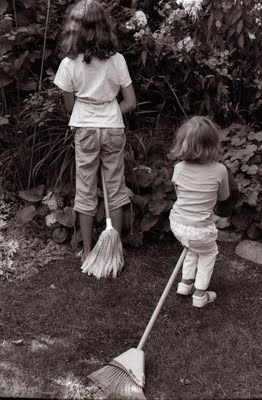 In all my years as a freelancer in Vancouver weekends were really no different from weekdays. Then there are the perceived seasons. Every time I run into someone who asks me, “How was your summer?” I either answer sarcastically or I don’t answer at all. What is seen as sarcastic is when I explain that since I work when I can, I don’t necessarily have summer holidays. Summer can be just like any other season. Sometimes I cite that beautiful moment in the Robert Redford film version of F. Scott Fitzgerald’s Great Gatsby. Redford (in white slacks) and someone else are walking on the side of swimming pool. It is a brilliant and sunny afternoon. One of them says to the other something like, “It was a fine summer.” For a freelancer I think that every day is a scary Monday and more so now with a decline in the magazine business and the resulting decline in the need for photographs. But I have to admit that weekends are now weekends for me. Saturdays are the days when Rebecca and Lauren spend the day with us. I anticipate their coming days in advance and I feel a bit on the sad side when I drive them and their mother home on Saturday nights. Mondays are now special, too (and less scary) as we take care of the kidsin the afternoon. I pick them up at school and cook a quick lunch for them. Hilary shows up later for dinner. 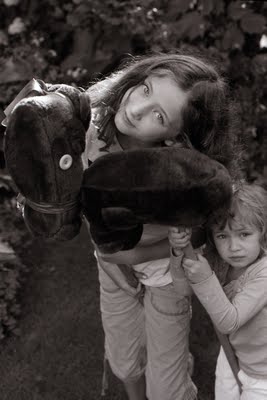 This last Monday I took Rebecca and Lauren to the main branch of the Vancouver Public Library, Both girls are feeling comfortable with the place and Lauren who has learned to read in English in the last weeks (she is in French Immersion) is able to find books and sit at the small tables and make her selections to borrow. Rebecca sits on the floor and looks at her choices. She loses track of time. I found a 2000 film version of Jack London’s Call of the Wild. I knew I wanted the girls to see it. But I also knew I had my own reason. The lead actor is Italian born actor Nick Mancuso whom I met in Vancouver some years back. After dinner (Rosemary had to work with her laptop) the girls, Hilary and I watched the film which was truer to the novel than the 1935 version with Clark Gable in which the whole plot revolves on Gable running into Loretta Young in the frozen wilderness and the dangerous thaw that follows. At first Rebecca wanted to go home. She was soon drawn in by the beautiful dog, Buck. I made it like I was being bored and that I was going to turn it all off. Rebecca knew I was kidding. It was an enjoyable evening and when I delivered them home it felt like a Saturday night. 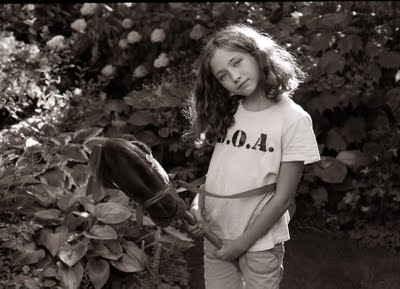 Today Rosemary and I pollarded the hawthorn tree in the front and even though I wore gloves I got many nasty thorn punctures. I spent the rest of the day trying to get rid of the pile of photographs, negatives and slides that perennially occupy the floor on the left of my computer and scanner. No matter how I hard I try, there is always a pile. The problem is that I find long lost stuff in it. Today I found a beautiful print of my grandmother Ellen Carter (sent to me by my uncle Leo Mahdjubian about 17 years ago) which I had lost for about 6. I also found a set of b+w negatives that included some of Rebecca and Lauren riding some brooms that they converted to horses with cloth heads and sewn-on buttons for eyes. When I found them I became melancholy. It was Wednesday but it felt like Saturday or Monday. I believe I must have taken the photographs last summer. Jay Gatsby: Summer's almost over. It's sad, isn't it? Makes you want to - I don't know - reach out and hold it back.
Nick Carraway: There'll be other summers.For me there was last summer with the broom horses, this summer, and, I hope Nick is right and that there will be more summers to come.
Triremes - A Kriegsmarine Submariner & A Leaky Bed
Tuesday, November 10, 2009
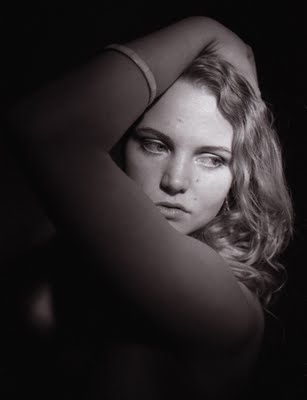
Honest blogs can be embarrassing sometimes. But then I believe that within limits a blog is a web log. And a web log is a digital diary. If I wanted to stress this idea I would begin every day’s blog with that ever so quaint Dear Diary, …
Sometime in the mid 60s I was a room boarder in a home owned by a retired U-boat man and his wife. I was in the Argentine navy and because of my English I was spared the horror of a small destroyer bobbing and yawing in the South Atlantic and had the privilege of a desk job and an Irish/Argentine secretary. I also had the choice of living in barracks and be subjected to vicious petty corporals who liked to play soldiers in earnest or I could opt to renting a room. I chose the latter. To pay for the room I worked as a waiter in a bar in the Boca on weekends.
I was 22 years old.
This is something the submariner’s wife could not understand. She would get angry at me when I had uncontrolled nighttime fluid emissions and I would “dirty” her pristine sheets. I tried to explain to her that I could not control my nighttime subconscious. So she insisted I sleep with a towel under me and over me. When I started getting dreams involving the Gestapo I decided to bid the submariner goodbye.
Now at age 67 when I walk on Granville on the odd late evening (something I do not do with any regularity) I do not look at the noisy bars (the noise has to make up for the lack of smoke or perhaps noise used to be dissipated by tobacco smoke) with any kind of jealousy or longing. I do not wish to be young and be looking for a woman or a partner or someone I may want to live with or marry. That is in my past. Perhaps the only advantage of youth that I am truly jealous of is that idea of falling in love, of even falling in love for the first time.
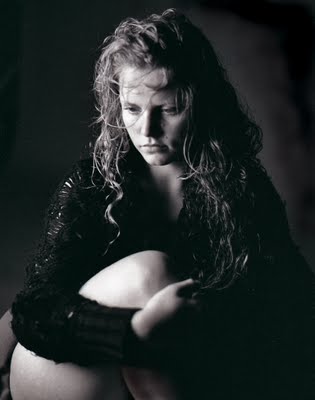
Time dulls all that and I don’t see myself dumping Rosemary, selling the house and buying a brand new Maserati to try to capture a lost youth. The Maserati I still own, is rusting in the garage and there is no way I will bring back my pipes. I would feel like that Playboy guy. He has no idea of what it is to have grace in old age and to make an unburdensome exit. Besides I can see at least one bed towel in my future as the body inevitably lets go of controls.
All this is but a prelude. It is an overture (if I am going to be repetitive about all this). It is setting up the reason for posting these two pictures here. There would be other pictures but there are self-imposed restraints that prevent me from showing you that not only does Quilla have a face to launch a fleet of triremes but a body that in water would have prevented that Eureka moment for Archimedes who would have sunk into his bath with a heart seizure.
We have had Quilla twice as one of our nude models at Focal Point. The first time was last year. She did not have a bank of tattoos all over her body. She has only one on her ankle (away from other more relevant areas) and would you guess that it has a saying in Spanish? It is something about the fact that if you don’t dare you won’t get anywhere.
It is my premise here that when one has arthritic pinkies (my case at the moment), a sore elbow (result of having broken it a couple of years ago) and when sustainability is simply, and, alas, only, being able to stay in bed in the morning, with some measure of controllable discomfort, in spite of having to go to the bathroom, any opinions I may have about the fair sex must be purely objective, with no vestige of desire or anything else.
This is comforting in many ways. It means that I may just approach Quilla in some future project that will help me sustain my interest in this momentarily unsustainable profession of mine which is photography.
Sam Sullivan's Project & The Project
Monday, November 09, 2009
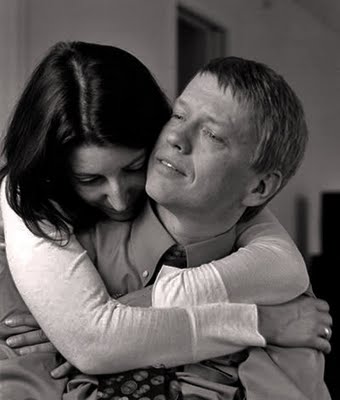 Two events on the same day, last Thursday, November 5 left me with thoughts running around my head like cockroaches on a kitchen counter in the middle of the night in the tropics when one turns on the light. The activity was brutal. At first one would think that former Vancouver city mayor Sam Sullivan’s unveiling of his Global Civic Policy Society at the Pan Pacific Hotel Crystal Ballroom would have nothing in common with the Solo Collective, Aaron Bushkowsky’s play The Project (directed by Rachel Peaks) which opened Thursday night at Performance Works on Granville Island. The venues were different, the audience was different, the food was better (Sam had a better budget than the Solo Collective which was celebrating its tenth year of existence and had a modest table with goodies) but in the end it was a similarity in language that stuck out for me. Both events showcased the failure of language be it through repetition or through a false projection of relevant and instant intimacy. Sitting between the lovely, refined and ever so much fun Leila Getz and Martha Lou Henley at the Crystal Ballroom of the Pan Pacific I heard host Mike Harcourt introduce UBC luminaries on the environment, density and other relevant urban affairs give short talks on Sam Sullivan’s organization which received a five hundred thousand dollar contribution from Charles Annenberg Weingarten and the Annenberg Foundation and from local philanthropists. It is Sullivan’s idea (based on practical experience) that more can be achieved to save our city, region and planet not through or within politics but by intelligent advocacy run by experts. I spotted such experts as former Councilor Gordon Price and urbanist Ray Spaxman. I was most pleased to see that Sullivan had taken some of the council from his Philosopher-King-mentor, Abraham Rogatnick and has brought into the fold of Global Civic, the gentle architect Bruno Freschi. With a bit of Sullivan's passion (with a bit of help from his wife Lynn Zanatta, picture above) the venture might succeed. Had I had a golf counter in hand I would probably have suffered finger damage clicking the times I heard the words sustainability, affordability, peak oil, green, livability, global warming, carbon dioxide emissions, eco-density, and the expression, “our cars will grind to a halt.” It would seem that the very issues that are so important to our future wellbeing are defined by words, so often used, that they harmlessly bounce off our brain like Darfur, ethnic cleansing and pandemic. At Performance Works The Project began with actress Sarah Rodgers mimicking in a simulated TV monologue those Saturday afternoon TV programs that my granddaughter Rebecca loves where Canadian celebrities appeal to our wallets by showing us starving children in darkest Africa. The only difference here was that the more Rogers put emotion into her delivery the more the crowd around me laughed. I could not understand why. It took me a while to get it. The whole play is populated by characters who talk in made-for-television cliché. While watching CNN’s Larry King Live I can only take a few minutes before his “instant” and “intimate” rapport with his subjects disgusts me into switching channels. Somehow, in the theatre I found it (eventually) very funny and I laughed with the rest. My Rosemary resisted, but she finally succumbed to the play and the excellent actors. Andrew McNee as Fred the famous (in the play) documentary maker was so perfectly believable I would have purchased a used clunker from him on the spot. Lindsey Angell (see, below, left) was so spot on as the really smart but paradoxically vacant Hollywood blonde that I felt sorry for her at times but marveled at her ability to come back in others. Alvin Sanders shifted from being the typical corrupt Dark Africa bureaucrat to a scary guerrilla leader (the ones that command others to cut off limbs) that I would have put my grandchildren to sleep easily by pointing at a true bogey man. The play came closer than the earlier lunch to showing me why nothing seems to ever get done in spite of all the talk. 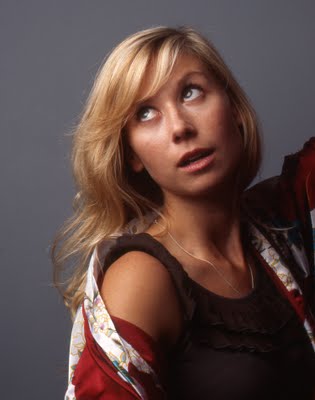 Both events showed me that the way to our hearts and pocketbooks, if we are going to see any positive change is through the intelligent manipulation of language. The play, which so many might see as a comedy produced in me a realization, a catharsis of sorts on how language has deteriorated. Would it be possible for Franklin Roosevelt to affect us with his “Fireside Chats” in our present world? Would they be Twitterable? Will Sullivan’s Global Civic Policy Society achieve results by only circumventing politics? I would think that Bushkowsky’s play points in the direction that the language of intimacy is at a crossroads. Intimacy has to be earned with time. There can be no (realistically) shining light on the road to Damascus while waiting in line for that Americano at Starbucks. I feel that advocacy has taken away from us that ever so useful word gay so much in the vocabulary of that exquisitely funny and intelligent (and gay) Noel Coward. I feel the same way about those words I heard at the Pan Pacific luncheon. Sustainability for me has always meant to keep something up which at my age is mostly a pipe dream. We need to find new words to get that audience to listen to us. I would seem to me that Sam Sullivan might just want to hire Aaron Bushkowsky and other local plawrights to help him. We only have to look in the direction of the Czech Republic to realize that playwrights can change history. I am sure that Voltaire would agree. Addendum: Sustain has a Latin root sustinēre. It is curious that the Spanish who like to keep their language free, when possible, of Anglicisms and Gallicisms eschew brassiere and opt for the more Latin sostén. It would be nice to see such green ads as: I dreamt I was far more sustainable in my Maidenform bra.
High-Strung - Shadow/Highlight
Sunday, November 08, 2009
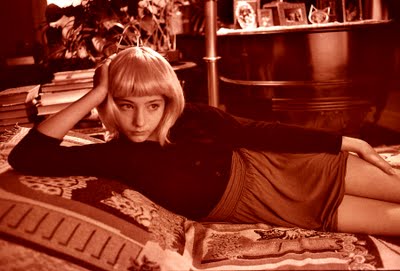
For the last couple of years I have been trying to nail down the difference in appearance between digitally taken photographs and those exposed on film. I use the expression digitally taken as, particularly in my case, when my photographs are reproduced here, in magazines, newspapers and brochures those film images have to be digitized. I use an Epson V-700 scanner that came my way via the generosity of Georgia Straight editor, Charlie Smith. I scan my b+w negatives (old colour negatives), transparencies (35mm ones taken with my Nikons and 6x7 cm taken with my Mamiya RB-67). The scanning process brings with it an inherent extra contrast which I must then reduce by using Photoshop CS. This means that no matter how much of a purist I say I am (and I don’t) there is no such thing as a Photoshop-free image in this blog.
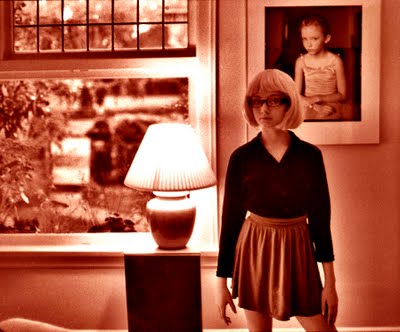
My Photoshop CS has an image adjustment feature called Shadow/Highlight. With it I can not only bring back the shadow detail lost by my scanner but also reveal a lot of that shadow detail that previously (I must admit) was not achievable even with very good photographic paper in the darkroom. To clarify this, what I want to say is that Photoshop is not inventing shadow detail that is not there, it is simply exploiting (a drawing out) the ability of good professional film (in my case Kodak Ektachrome-G) to capture shadow detail. Until the advent of digital imaging and printing and good printing presses this detail, which was always there, was lost to the limitations of that pre-digital age.
This means that my scanner in conjunction with Photoshop CS and Corel Paint Shop Pro-X (a little secret of mine) become useful tools for the conversion of my film images into digital ones. But I still think that my images look different from the ones to be found in the social networks like Facebook and Flickr. That difference I have come to understand is the slow demise of additional lighting (soft boxes and grid lights attached to studio lighting systems).
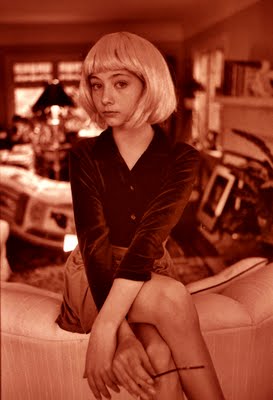
There is another difference and for that I must use the pictures I took of Rebecca yesterday afternoon in our living room. I used Kodak Tri-X and a Nikon FM-2 with two lenses. One was a 50mm F-1.4 and the other a 35mm F-2. My exposures were at the limits of hand-hold-ability, 1/30 at f-2 or 1.4. I did not want to sacrifice the small camera freedom by resorting to a tripod. I scanned the negatives as b+w negatives but scanners still include the red/cyan, blue/yellow and magenta/green. This means that I can tint the pictures to my heart’s content. These are the results of an extreme shift to red plus a tad of yellow.
By the very fact that I am using b+w film I am narrowing down my choices. The 400 ISO speed rating of my film further narrows down my choices.
The digital shooter is prone to shoot in colour (to increase options at the time of making decisions in the post-taking- the-picture which is called digital work flow. The digital shooter will use a mode called RAW in which the shooter can put as many eggs into the digital basket. I believe that it is here where the film shooter and the digital shooter diverge with a resulting difference in the appearance of the pictures (even if the digital photographer will swear up and down that it makes no difference and the digital image can be made to look exactly like the one with film).
I think that the difference occurs simply because the moment I use b+w film of a certain speed I reduce my options. By reducing my options I can spend time taking pictures not worried by the subsequent limitations. These subsequent limitations are the very reason for the look, at least in my case, of my pictures.
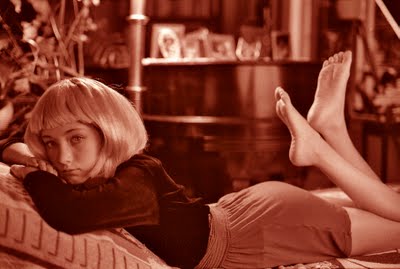
I planned yesterday’s shoot with Rebecca a week before. I called up Hilary and asked her to tell Rebecca to bring clothing she had been given as a gift. This was adult clothing owned a woman who is almost Rebecca’s size. I told Hilary to tell Rebecca that I was going to try to make her look 20.
Rebecca did not pay attention to my requests and only brought her blonde Halloween wig and a purple top and black sweater. We did not start in a pleasant manner and the session (very short as I only took 16 pictures) quickly deteriorated in a mutual shouting match. “I have a headache. I want a break. I want a rest. I don’t want to pose anymore,” she told me in her high-strung (could it be she might just one day be one of those high-strung models that make more in one hour than what I make in one month?) rapid fire voice. We stopped at 14 exposures and I felt abandoned and frustrated. But I also knew that I had some good pictures in those 14. Could it be that Rebecca’s imposition of a limitation on my shooting further explains why my pictures don’t look like so many of those in social networking sites?
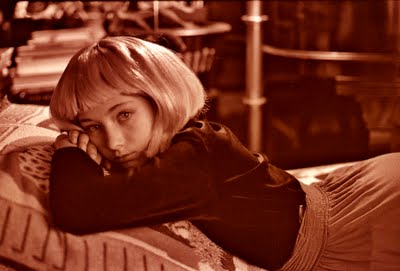
For me these small camera sessions have brought an excitement of what it was like to take pictures when I was young before I became an all-knowing cynic. I will just have to be more careful as I collaborate in this re-exploration of an untethered photography. The way must lie through a little girl who in growing up knows she is in control. And she is.
Kiki de Montparnasse
Saturday, November 07, 2009
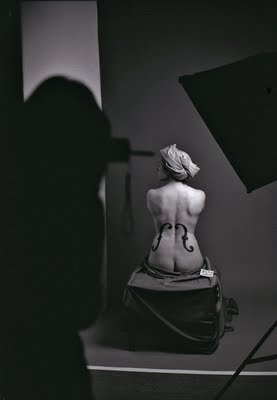
A couple of months ago I received a call from Patrick Blaeser who is the Program Coordinator: Certificate & Part Time Programs at Focal Point. “Alex, I have an idea of a course that you might like to teach. It would be called portraiture through the ages.” I thought about it and told him I would get back to him.
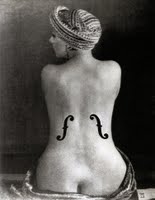
In the last few years I have been thinking a lot on how photography has progressed since Niépce took that first picture from his kitchen window in 1824. Because I was raised with books (I am a pre-internet baby!) I have many photography books in my library. I have amassed a considerable collection. My memory is still good. I remember most of the photographs of all of those books.
Without really knowing it, when I take a photograph, there is always an element of that photograph memory of the past. In some way every snap of my shutter is inspired by those photographs. But they are not only photographs of the past they can also be inspired by a painting or a sculpture. These works can be by artists who may be contemporaries to photography but many also preceded the age of photography.
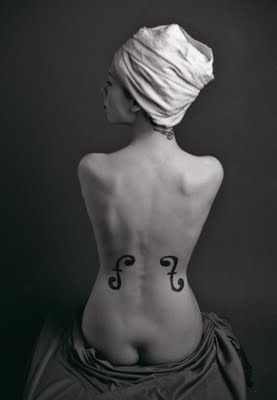
As an example when I teach nude photography and we have a male model, sooner or later we explore Rodin’s The Thinker or Michelangelo’s David. Just about every time I bring in a mirror into a studio I recall Diego Velázquez’s Las Meninas.
I didn’t linger much before I called back Patrick to tell him I was very excited. The class began six Wednesdays ago. It is a three hour class held every Wednesday for ten weeks. This last Wednesday we brought back two of our favourite models, Shannon and Jerry. Shannon is voluptuous and Jerry is slim but curvaceous, nonetheless. Jerry admires Bettie Page. Jerry’s skin is white and she sports several tattoos and body piercings in strategic areas.
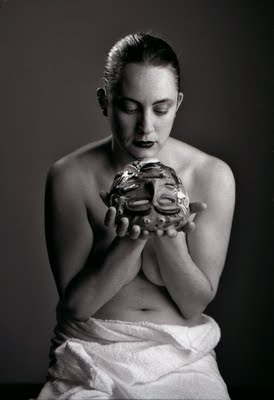
In this sixth class we worked with the inspiration of some of the photographs that Man Ray took of his model Kiki in the 20s. The more famous one is called Kiki, Ingres’s Violin. The joke of the name is that in French that name also is about obsession. Perhaps, as some say, Man Ray was not particularly inspired by the nudes of Ingres as much as using him as the excuse to get Kiki to take her clothes off.
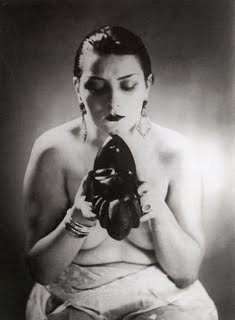
The second picture is called Noire et blanche. In the 1920s African masks were all the rage. Even Picasso was part of that primitive movement. Since I did not have an African mask at home I brought a Mexican one made of clay.
For the f-holes we used dry erase writing board markers. One of my students, Nicky was a skillful wrapper of turbans. She also drew the f-holes and insisted in making stencils out of paper. In the first picture you can see her silhouette as she takes her picture of Shannon.
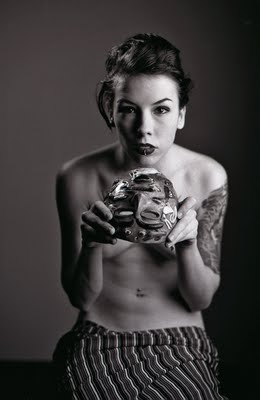
The second artist we worked on was El Greco. For this we took advantage of Jerry’s slimness. Alas I was too busy making sure everybody was doing what they were supposed to be doing so I was not able to snap any of the El Grecos. For the pictures you see here I used a Nikon FM-2 with a 50mm F-1.4 lens. Shannon could afford to rest for this as she had been very good in a previous class as John Singer Sargent's Madame X.
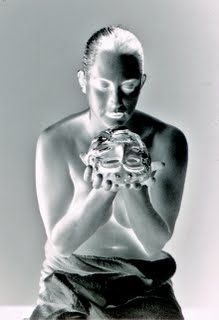
I worked with Kodak Tri-X and my exposures were 1/60 at f-2. I used the modeling lights of the flash units as I did not want to take shooting time from my students.
It has been a while since I have felt so excited about a class I teach. Thank you Patrick.
Addendum: Unlike our efforts where we drew the f-holes on the back of the models Man Ray drew them on his prints. It would be interesting how many of these he drew and if all those originals of his are really reproduction copies of the few he actually drew.
more Kiki via Peggy
Revealing The Serendipity Of Failure
Friday, November 06, 2009
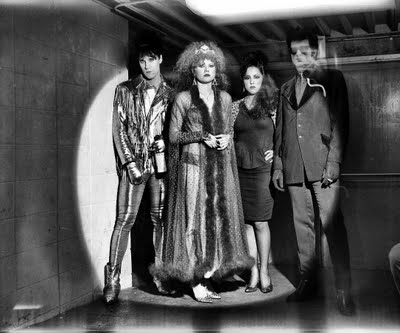
I like to think of the serendipity of failure as one of the most welcome methods of achieving new results with the photographic process. Sometimes that failure is suppressed for years (in this case it was a period of 24 between the taking, 1985 and its revealing.) It is interesting for me to point out that to develop a negative or print in Spanish we use the verb revelar which also means to reveal as well as to make visible that which is hidden.
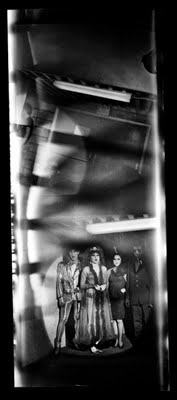 I find the word magical as it stresses less the mechanical process and more on what the image itself will show of itself, its maker and his subjects.
The failure here involved opening the film back to light after the exposure of the pictures. The event was at the Sub Ballroom at UBC. It was a concert with The Cramps and two local bands of note, the Modernettes and Slow. I don’t think that any of the pictures (there are 7 exposures in my files) were ever used. There may have been more but the sudden opening of the back would have ruined at least half of them. At the time I was using 220 film which meant I had the possibility of exposing 20 frames.
With the advent of good scanners I am able to “restore” these pictures to some degree of contrast and sharpness while retaining some of the intangible charm of the inadvertent gross overexposure.
More Failure.
zemblanity.
The Cramps.
Bishop's Castle, Capablanca, Capdevila & Chess
Thursday, November 05, 2009
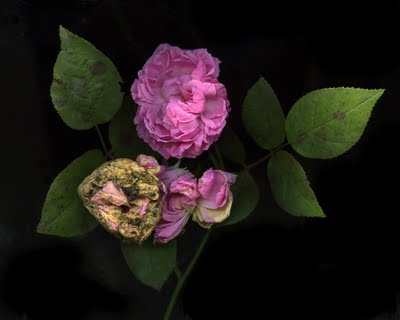 Arturo Capdevila El tablero de ajedrez (fragmento) " Como en la vida, todo es problema en el ajedrez, desde la apertura hasta el mate. Pero todo es equidad y todo es ley. Tengo aquí peones, Caballos, Alfiles: están medidas mis potencias. Puedo adquirir, sin embargo, nuevas fuerzas por la combinación acertada de las que me han sido consentidas. Y, a la inversa, puedo disminuirlas o perderlas. Nadie sino yo tendrá la culpa de esto. Una combinación errónea me traerá siempre a menos, bajo el jaque del rival. De donde se infiere, provechosamente, que la violenta ambición es perversa consejera, y que tan sólo se ha de tomar en cuenta el interés de la armoniosa verdad. La multiplicidad de peligros de que vivimos rodeados se evidencia en el tablero. Hemos jugado por fin. ¿Qué hará el adversario?... Es el dueño de innumerables posibilidades; el mero paso de su peón, con ser nada más que un peón, puede comprometer todo mi plan y ocasionar mi ruina. Lección incomparable, que nos instruye en la suprema ley de la relatividad. ¿Y lo que se pierde, se pierde para siempre? El ajedrez nos da un consuelo. Si cuidamos la marcha de los ínfimos peones, tan pequeñitos como son, apoyando su avance con bien distribuidas fuerzas, alguno de ellos entrará a los últimos cuarteles del adversario y será nuestro precio de recate por la pieza grande que entregamos en temerario arranque al lazo del enemigo. Así, del propio error viene a servirse el ajedrizta paciente para la ulterior victoria. Parece que por tales caminos se nos aleccionará de que no hay modesta intención ni altruista constancia que al cabo no fructifique. Porque todo este juego se funda en el ejercicio altruista de los poderes, como se ve de inmediato cuando se considera que siendo el Rey la pieza menos útil, por él pelean las demás, denodadas y terribles. También se advierte que la pieza jaqueada no atiende nunca a su particular salvación sino a la del conjunto que se le sobrepone. "Arturo Capdevila (1889, Córdoba, 1967 Buenos Aires) Yesterday I toured our garden and saw one of my roses, uncharacteristically in bloom this late in the season. It is an English Rose called ‘Bishop’s Castle’ Two years ago when I first purchased it, the bush was glorious with multi canes and blooms. But it has ultimately been a poor grower. Now it is a sorry spindly thing. I am not all that sure it will come back for next spring. The very thin cane was bent over and one of the blooms was dragging on the ground. But one of he others was in all of its glory and in spite of the cold weather I could smell its exquisite scent. It is a scent that will remain in my memory, as the days become wetter, colder and bleaker, until spring. I wondered why the rose had the name. The first thought in my mind was that it could have something to do with chess. I quickly shifted my thoughts to other possibilities as the only chess connection would have to do with moving both the bishop and the knight out of the way and or the queen if one were to castle (the only move in chess where two chess pieces, the king and the rook, are moved simultaneously). 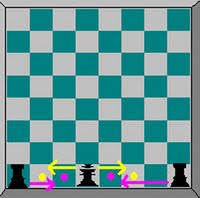 But while I finally found out that the name has to do with a small market town in Shropshire (close to where David Austin hybridizes his roses) by the same name, chess lingered in my mind. I began to play chess when I was 8 but I abandoned it when I was 20. I realized I could never be anything but a competent player. In losing in chess one quickly learns to eliminate all excuses, and what is left, is surely a lack of intellectual activity and a torpid movement of electrical impulses in one’s neurons. Simply put, I was too stupid to be a good chess player. 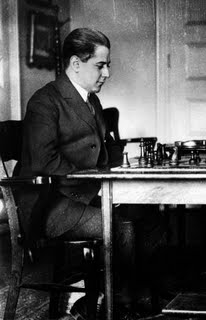 Until it finally sank in, I read books on chess and my hero was the Cuban chess master with the beautiful name, José Raúl Capablanca. I had a two-month chess rennaissance in 1966 when I was on board a slow Argentine ELMA (the Argentine merchant marine) Victory ship, the Rio Aguapey en route from Buenos Aires to Veracruz. As soon as the captain Guillermo Magliorini found out I played he summoned me every night to his quarters for a match. I think that we were pretty even so when I disembarked my pride was almost intact. In the late 50s I would take the bus to downtown Mexico City to Calle Palma. Calle Palma had blocks and blocks of chess stores where I would stare at chess sets I could never afford to buy. Most of us, in those days would buy the cheap and hollow plastic pieces. We would fill them with sand to make them heavy and then we would glue on the bottoms the finest green felt we could find. The chess board was another problem. For years I had a foldable cardboard one but I finally was able to save enough to get a wooden one. I often would go to Chapultepec Castle to feast my eyes on the most beautiful chess set I had ever seen. The black obsidian players were Moctezuma, Cuauhtemoc and the fierce Aztec warriors. The jade players were Cortez, his captains and his soldiers. The chess board consisted of inlaid squares of obsidian and jade. The set disappeared in the early 70s. In the mid 90s I returned to Mexico City and I was able to secure an interview with one of the castle’s curators. She told me that the set had never existed and that I must have been confused with some other museum. Of late I have been thinking that I should buy a chess set and teach Rebecca. I am sure that her neurons would be able to accommodate more chess activity than her grandfather’s.
|






























